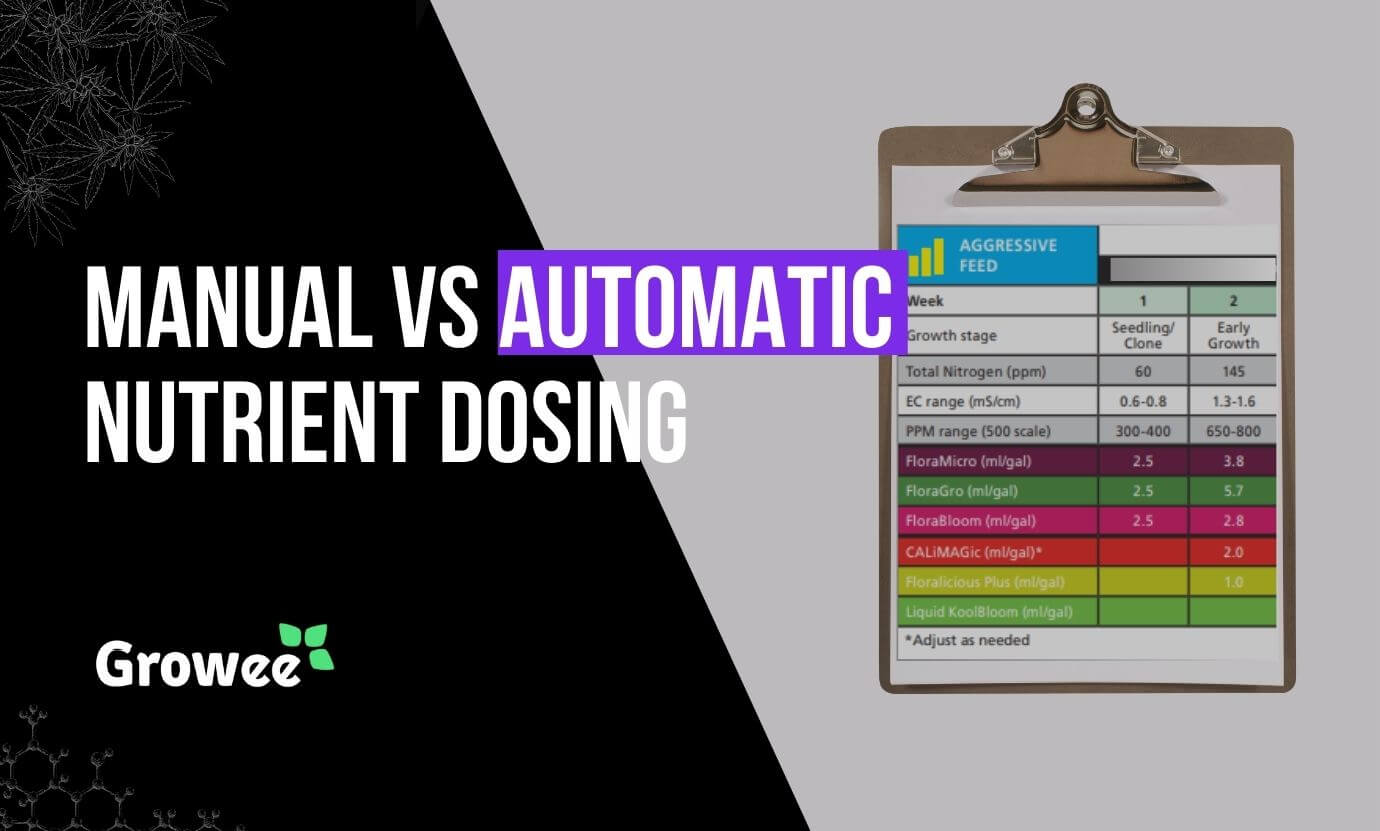Hydroponics, just like any other method of growing plants, requires those plants to have the proper nutrients. Seeing as hydroponics is all about growing plants mainly in a nutrient solution, how to make that nutrient solution is therefore crucial to your overall success.
Although a good automated hydroponic system does make a difference in terms of balancing the nutrients, being able to create the solution on your own is an integral part of hydroponics, and it’s what we’re going to teach you right now.
Importance of Mixing the Right Nutrient Solutions in Hydroponics
The foundation of hydroponic gardening lies in providing plants with an ideal nutrient solution. Unlike traditional soil-based gardening, where nutrients are naturally present in the soil, hydroponic plants are entirely dependent on the nutrient solution they receive. This makes it crucial to understand the composition of this solution.
Mixing The Nutrient Solution According To Your Plants and System
In hydroponics, nutrient mixing isn’t a static process but rather a dynamic and evolving one. It adapts to the changing needs of plants as they progress through various growth stages. Additionally, the grower’s goals and the specific hydroponic system in use play vital roles in determining the composition of the nutrient solution.
For instance, in small-scale hydroponic systems, such as those used in home gardening or smaller commercial setups, the grower may need to mix the nutrient solution several times a week. The frequency of nutrient mixing directly correlates with the rapid nutrient uptake of plants and the need to maintain optimal nutrient levels.
See How Growee Can Save You Time By Automating Your Plants Feeding
Water pH – Automated pH Up and Down Control
Nutrients Mixing – Automated Nutrient Dosing with Target EC / PPM Control.
Control From Anywhere – WiFi Connection and mobile App
Mixing Your Nutrient Solutions with Liquid Hydroponics Nutrients
- Water Quality Check:
Start by filling the tank with water. If your tap water’s electrical conductivity (EC) exceeds 0.6, it’s advisable to dilute it with Reverse Osmosis (RO) water to achieve the desired starting EC.
- Referring to the Feeding Chart (Week 1):
- Suppose you have a 100-gallon reservoir.
- For Week 1, your target EC falls between 0.6 and 0.8.
- According to the chart, you need to add 2.5 ml of each of the three different nutrients per gallon.
- So, the total amount needed from each nutrient is 2.5 ml/gallon x 100 gallons = 250 ml from each nutrient.
- Maintaining Target EC:
- To prevent exceeding the target EC, add these nutrients gradually.
- Begin by adding a portion of each nutrient to the tank, Mix the solution thoroughly.
- Measure the EC after each addition and mixing.
Continue adding and mixing until the EC reaches a maximum of 0.8, staying within the recommended range.
- Balancing pH:
- Add pH up or pH down solutions incrementally.
- Mix the solution thoroughly after each addition.
- Wait for a few minutes to allow the pH adjustment to take effect.
Continue monitoring and adjusting the pH in intervals until you reach the target pH level of approximately 6.0 while ensuring the EC remains within the desired range.
Overall time for doing it manually: 1 hour.
Mixing The Nutrient Solutions Automatically Using The Growee Smart Dosing system
Now let’s see what this process looks like using an automatic dosing system like Growee.
he Growee automatic dosing system is a game-changer, simplifying nutrient solution management and reducing labor to just 1 minute.
Users input the feeding chart values, the required ml/gallon for each nutrient, as well as the Target EC and Target pH directly into the Growee App.
This information is seamlessly transmitted to the system via the Growee cloud. Once configured, the system precisely measures and dispenses nutrients while continuously monitoring and adjusting EC and pH levels using its integrated sensors.
This automated precision ensures optimal nutrient delivery for your plants’ growth without the need for constant manual intervention.
Three Benefits of Using Growee Dosing Automation For Mixing Your Nutrients / Feeding Solution
Precision in Nutrient Ratios: Automated systems excel in maintaining precise nutrient ratios. This ensures your plants receive the exact blend of essential nutrients they need for optimal growth. Whether it’s nitrogen for lush foliage or phosphorus and potassium for robust flowering and fruiting, our system guarantees the right mix every time.
Labor Reduction: Say goodbye to labor-intensive manual nutrient mixing. Our automated system streamlines the entire process, reducing the need for constant monitoring and adjustments. This not only saves you time but also reduces the risk of human error, ensuring consistent and reliable results.
Optimized Plant Growth: Consistent nutrient levels maintained by our automation system promote healthier and more robust plant growth. No more guesswork – our system delivers remarkable results consistently, leading to increased yields and higher-quality crops.
The two most common types of off-the-shelf nutrients for hydroponics
There are two primary types of nutrients commonly used in hydroponic systems: liquid nutrients and powder nutrients. Understanding the characteristics and benefits of each type is essential for hydroponic growers.
Liquid Nutrients: Liquid nutrients are formulated as a series of 3-8 different components, each containing specific essential nutrients. These components are designed to provide a balanced diet for hydroponic plants throughout their growth cycle.
Liquid nutrients offer precise control over nutrient ratios and are suitable for beginners. Growers follow feeding chart instructions provided by the manufacturer, adding these components separately to water at different stages of plant growth. However, this method can be time-consuming and may require daily adjustments to maintain the ideal Electrical Conductivity (EC) and pH levels.
Powder Nutrients: Powder nutrients come in the form of a fine powder that needs to be dissolved in water before use. Many hydroponics nutrient companies have added powder nutrients to their product lines due to their ease of production, cost-effectiveness, and transport convenience.
Powder nutrients are easier to store and handle. They come with feeding charts and instructions similar to liquid nutrients, ensuring precise nutrient mixing. However, achieving the correct ratios can be challenging for beginners.
Some Important Notes About Making Your Nutrient Solution
The above are just general guidelines on how to make your own nutrient solution, but there are also some other pieces of information you should be aware of.
Generally, every week, the ratio of the components needs to be different according to the growth timeline of your plan. The nutrients in question should come with mixing instructions for every consecutive week.
However, powder nutrients are now becoming more common, mainly because they are easier to use, they don’t cost as much, and are easier to transport as well.
That said, powder nutrients still need to be mixed properly as well, and getting the ratios right can be difficult. Even experienced growers who think that they can mix their own nutrients properly without any kind of measurement tools often get the levels totally wrong!
Factors that Affect the Nutrient Needs of Plants
Various factors affect how many nutrients plants need, and which ones they need too. Let’s take a look.
Plant Species
The species of plant makes a big difference in terms of nutrient needs. For instance, potatoes may require slightly elevated levels of nutrients when compared to other plants.
Growth Stage
The growth stage that a plant is in makes a difference too. For instance, plants in their vegetative growth state generally require more nitrogen than anything else, whereas when they start flowering, phosphorus and potassium become more important.
Environmental Conditions
The environment makes a difference as well, because plants need certain temperatures and humidity levels to grow properly. If a plant is being grown in conditions that are not ideal, it may inhibit nutrient uptake. Moreover, plants in colder climates tend to grow a bit slower, and may therefore not need as many nutrients at once.
Water Quality
The other deciding factor here is water quality. For instance, if the water is already full of minerals like calcium and magnesium, then you’ll need to add much less of those to your hydroponic nutrient solution.
Conclusion
In conclusion, hydroponics stands as an exceptional method for plant cultivation, offering a wealth of benefits. However, it requires vigilant attention when it comes to nutrient management. The delicate balance between too little and too much of any nutrient can have catastrophic consequences for your plants. Ensuring the right ratios is paramount for success, but it’s not always an easy task.
Enter the Growee Automated Nutrient System, the solution to your hydroponic nutrient management challenges. This innovative system takes the guesswork out of the equation by automatically mixing nutrients according to the precise ratios required for your specific plants. Moreover, it monitors and adjusts electrical conductivity (EC) and pH levels, guaranteeing an optimal environment for your plants to thrive.
With the Growee Automated Nutrient System, hydroponic gardening becomes more accessible, efficient, and yields impressive results consistently. So, whether you’re a seasoned grower or just starting your hydroponic journey, consider embracing the future of nutrient management. Make your hydroponics adventure a thriving success with the Growee Automated Nutrient System – because it truly doesn’t get much easier or more rewarding than this!
FAQ
Can I make my own hydroponic nutrient mix?
Yes, you can make your own hydroponic nutrient mix as long as you tailor it to the specific plants you are growing.
How often should I change the nutrient solution?
How often you change the nutrient solution depends on various factors. For fully grown plants, changing the solution every two to four weeks should be more than enough.
What will happen if I don’t use the nutrient solution?
If you don’t use a nutrient solution in your hydroponic setup, your plants won’t grow. Plain water has no nutrients in it, and this means that your plants will be lacking in nourishment all around.
Is homemade solution better than premade nutrient solution?
If you are able to mix the proper solution with the right nutrient ratios, EC, and pH level, then a homemade solution can be just as good as a store bought one.
Can tap water be used for hydroponic nutrient solutions?
Yes, you can use tap water, although be careful that it is pH balanced and that it does not contain elevated levels of chlorine.
How to measure NPK levels in hydroponics?
All you need to measure the NPK levels in hydroponics is an EC or electrical conductivity meter, or a nutrient testing kit will do as well.



